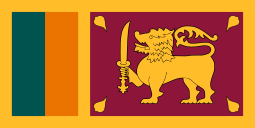Flag of Sri Lanka
 | |
| Use | Civil and state flag, civil ensign |
|---|---|
| Proportion | 1:2 |
| Adopted | May 22, 1972 |
| Design | Dark red rectangular panel bordered yellow containing a yellow lion holding a sword upright in its right fore paw, and four pipul leaves, one in each corner, and next to the hoist two vertical stripes, green and orange, also bordered yellow together. |
 | |
| Use | Naval ensign |
| Proportion | 1:2 |
| Adopted | 1972 |
| Design | White with the national flag in the canton. |



The Flag of Sri Lanka, also called the Lion Flag, consists of a gold lion, holding a sword in its right fore paw, in front of a crimson background with four golden bo leaves in each corner. Around the background is a yellow border, and to its left are 2 vertical stripes of equal size in saffron and green, with the saffron stripe closest to the lion. The lion represents bravery, and the four bo leaves represent meththa, karuna, muditha and upeksha. The orange stripe represents the Sri Lankan Tamils, the green stripe represents Sri Lankan Moors, the crimson background represents European Burghers and is also a reference to the rich colonial background of the country and the yellow border represents other ethnic groups such as Sri Lankan Malays etc.
It was adopted in 1950 following the recommendations of a committee appointed by the 1st Prime Minister of Ceylon, The Rt Hon D.S. Senanayake.
History
When Vijaya, the first King of the island of Sri Lanka, arrived in Sri Lanka from India in 486 BCE, he brought with him a flag with a symbol of a lion on it. Since then the Lion symbol played a significant role in the history of Sri Lanka. It was used extensively by monarchs who followed King Vijaya and it became a symbol of freedom and hope. When the legendary King Dutugemunu embarked on the campaign in which he defeated the Tamil King Elara, who had occupied part of Sri Lanka, he carried with him a banner which portrayed a lion carrying a sword on his right forepaw along with two other symbols, the Sun and the Moon.
The banner was in use until 1815, when the reign of the last king of the Kandyan Kingdom, King Sri Vikrama Rajasinha, was brought to an end with the Kandyan nobility's signing of the Kandy convention on 2 March proclaiming King George III as King of Ceylon and replacing the Lion flag with the Union Flag as the national flag of Ceylon. The government of British Ceylon used its own flag. The Lion Flag was taken to England and kept at the Royal Hospital Chelsea. As the years passed, the design of the flag was forgotten by the Sri Lankan public.
Then, as the independence movement in Sri Lanka gained strength in the early 20th century, E. W. Perera, a prominent figure of the independence movement with the help of D. R. Wijewardene, the press baron, discovered the original Lion flag in Chelsea. A picture of it was subsequently published in a special edition of the Dinamina newspaper to mark 100 years since the end of Sri Lankan independence. The Lion flag then became a centrepiece of attraction to the public, who for the first time since the fall of the Kandyan Kingdom were now aware of its actual design.
In 1948 the flag was adapted as the national flag of the Dominion of Ceylon, however the flag underwent several changes in 1953 and again in 1972. During the same year four leaves of the Bo tree were added to the four corners of the Sri Lankan National flag under the direction of Nissanka Wijeyeratne. At the time, he was Permanent Secretary to the Ministry of Cultural Affairs and Chairman of the National Emblem and Flag Design Committee. Prior to 1972, the corners of the flag were occupied by symbols depicting spearheads. The four Bo Leaves added by Wijeyeratne reflect the core principles of Mettha (loving kindness), Karuna (compassion), Upeksha (equanimity) & Muditha (happiness).[1][2]
Symbolism
The National Flag of Sri Lanka represents the country and its heritage as rallying device that integrates the minorities with the majority race. Most symbols in the flag have been given distinctive meanings.
| Symbol | Represents |
|---|---|
| The lion | The Sinhalese ethnicity and the strength of the nation. |
| The bo leaves | Buddhism and its influence on the nation. They also stand for the four virtues of Kindness, Friendliness, Happiness and Equanimity. |
| The sword of the lion | The sovereignty of the nation |
| The curly hair on the lion's head | Religious observance, wisdom and meditation |
| The beard of the lion | Purity of words |
| The handle of the sword | The elements of water, fire, air and earth |
| The nose of the lion | Intelligence |
| The two front paws of the lion | Purity in handling wealth. |
| The vertical orange stripe | The Tamil ethnicity |
| The vertical green stripe | The Muslim faith and Moor ethnicity |
| The yellow border round the flag | People from other cultures living in Sri Lanka |
| The crimson background | Other minor religions and ethnic groups, Portuguese/Dutch Burghers. Also refers to the rich colonial heritage and background of the country. |
See also
References
- ^ Amara Samara in Sinhala. Rivira, Retrieved on 4th January 2009.
- ^ Salute the Flag. The Bottom Line, Retrieved on 4 February 2009.
External links
